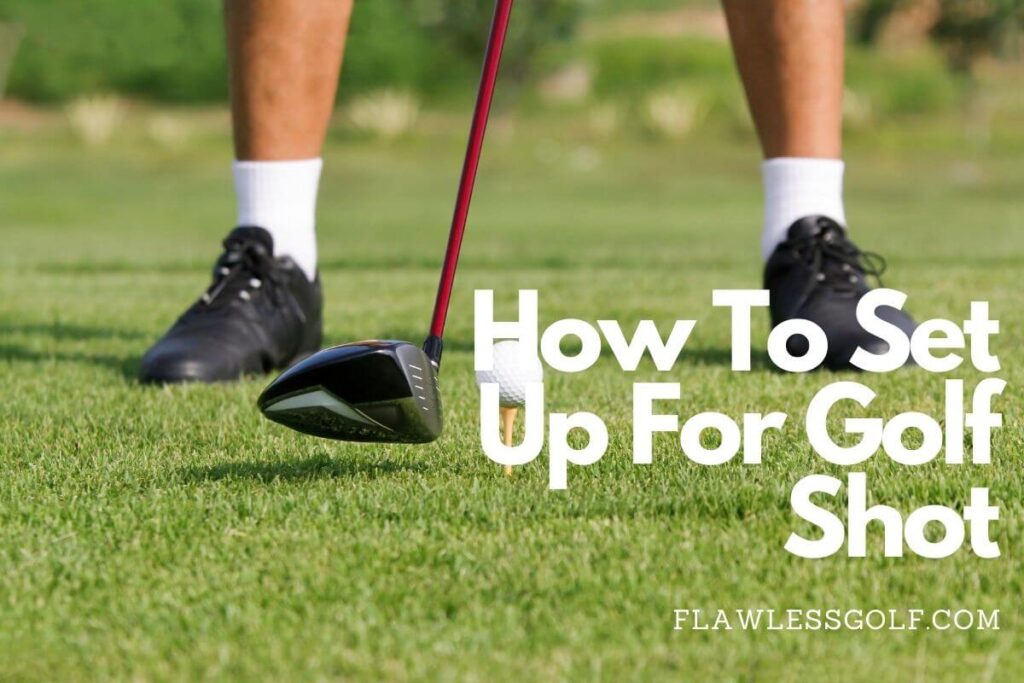Your set up position is the way your body is positioned before the beginning of a swing relative to the golf ball, to the club in hand, and to the target.
Having a quality set up position presents the opportunity to execute a solid swing as it helps to create the right attack angle and dynamic impact with the golf ball.
There are only four important aspects in your setup:
- posture
- alignment
- stance
- ball position
The most important of all is posture. Posture is first because the club hits the ball, your hands hold the club, which is attached to your arms, which are attached to your shoulders. So your posture has direct influence on the plane of your swing.
Your stance does not. It may have indirect influence. You may stand closed and take the club inside, or stand open and take the club outside. But your shoulders are attached to your arms, so they have direct influence. And that’s why posture is the most important.
Table of Contents
How To Set Up For A Golf Shot?
1. Posture
When you stand to the ball you need to bend forward from your hips so that your arms hang down from your shoulders. You should be in a comfortable position, but one which allows your arms the freedom to swing the club and allows your body to turn easily.
Bend forward until your arms hang straight down.

The bend forward from your hips should be approximately twenty degrees. Your rear end should be stuck out and up a little bit but not too much. It should feel like a ready athletic position, as if you were standing to field a ground ball or shoot a free throw.
Your weight should be toward the balls of your feet and evenly distributed between right and left. Your arms hang softly from your shoulders.
There should be no slouching forward from your shoulders. Your upper body should be free of tension, your back fairly straight.
Your lower body, in contrast, is the foundation of your swing. You need some tension there. The lower body should resist as your upper body turns in the backswing, hence the tension.
You want to feel a slight tightness on the inside of your legs all the way down to your ankles. Your lower body shouldn’t move much on the backswing. Any and all movement should stem from the turning of your upper body pulling your lower body along.
Your lower body does not initiate anything in the backswing. That’s why you need a solid base, one where your feet are almost fastened to the ground. Imagine if someone were to push you from any direction. If you wouldn’t fall over you know you are well balanced.
At the top you should be balanced enough to withstand a push from behind.

Everything is stacked on top of one another. Your head is on top of your shoulders. Your shoulders are on top of your hips. Your hips are on top of your feet. A line drawn up your back will be angled at about twenty degrees. A line drawn up the center of your body should run right through your left eye.
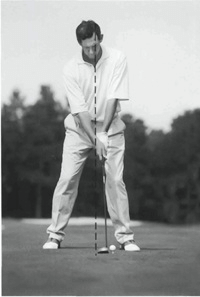
That’s as good as your posture needs to be to give you a chance to make a good swing. Good posture has a positive influence on your swing, just as bad posture has a negative effect. There are any number of possibilities, but here are a few to ponder.
If you bend forward too much from the hips, your shoulders will tilt more than they should as you swing and the club will tend to swing too upright.
If you stand up too straight, your shoulders will turn too flat and the club will tend to swing flatter than it should. The more you bend over, the lower your hands will be.
Low hands at address
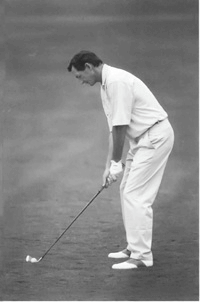
Low hands will send the club away to the outside.
sends the club away outside the line.
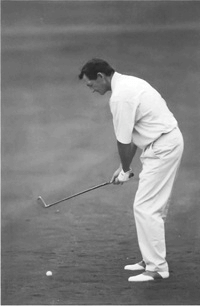
The more you stand up, the higher your hands will be. High hands will tend to make the club move too much to the inside. See how much even a little postural problem affects the plane of your swing?
Alignment
Proper alignment is easy to describe. You want to have your feet, knees, thighs, hips, arms, shoulders, and eyes all lined up parallel left of yourtarget.
That would be proper alignment. The bend in your right elbow makes up for the fact that your right hand is lower on the club than your left and closer to the ball, which keeps your shoulders and arms parallel with everything else.
Most important is the fact that they are coordinated correctly. Whenever students ask me where they are aiming I invariably have to wonder which part of the body they are referring to. Their feet might be closed. Their shoulders might be open. Their eyes might be angled left or right. They are pointed in so many different directions that it’s difficult for me to know where they are aiming.
The most important aspects of alignment are the shoulders, arms, and eyes. Your feet are important, but nowhere near as important as the other parts of your body. They receive more attention than they warrant considering their relation to the golf club.
What you may not know is that your eyes have a big influence on your swing. If you set up with them aligned to the right, you will probably swing that way. If you tilt your head more one way or the other, you’ll probably swing too steeply or too flat. You want to keep your eyes level to the ground and parallel to the target line.
At address, keep your eyes level.

That’s important for your balance and for the direction and angle of your golf swing. All because that is the way we function. Our whole world is based on being level to the horizon.
When you start tilting your eyes you run into equilibrium problems, which makes it hard for you even to put the club correctly on the ground behind the ball, never mind hit it squarely.
Almost everyone who reverse pivots swings the club back so that their eyes are at an angle looking down at the ground. If they kept their eyes level, they wouldn’t reverse pivot. That’s how I fix that problem.
Use the brim of your hat or the top of your sunglasses to check how level your eyes are throughout the swing.
One last thought. If you have watched Jack Nicklaus play golf over the years you have probably noticed how he always lines up on an intermediate target about a yard in front of his ball. The theory is that it is easier to align the clubface with something that close as opposed to a flag 200 yards away. I like that method. Try it.
Lining up a spot a yard in front of the ball can help your alignment.

Create Good Alignment (Drill)
Put a club down on the ground so that you can line up your feet
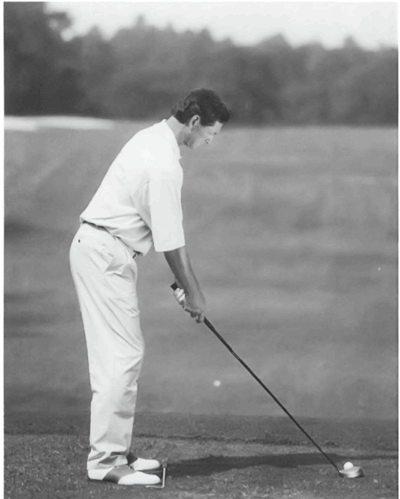
Then hold another club across your legs, just above your knees.
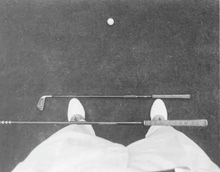
Use the club on the ground as a reference. When the two are parallel, your legs are aligned. Moving up, lay the club across your hips, aligning them. Then your shoulders and eyes.

If you have been aligned badly, you’ll be amazed at the different feel you have.
Now, set up to the ball. Your right hand is closer to the ball than your left. Your right elbow is bent. Don’t overdo it, though. I see many people tucking their right elbows in more than they need to.
That only aligns your arms to the right, which will encourage you to take the club away too much on the inside, then loop it over on the downswing.
Your arms should be parallel to the target line. If your right arm was perfectly straight, your arms would be lined up to the left. Try it and you’ll see what I mean.
So you’re set up. Your right shoulder should be just a little lower than your left shoulder, again because your right hand is lower on the club.
But no more or less than the amount your right hand is lower than your left hand on the club. You must align your body and the clubface together. The face must sit at right angles to your body lines. That is perfect alignment. Now you have given yourself a chance.
A point in passing. At address the toe of the club should be up just off the ground. When you swing, the shaft bends two ways; it arches down and back.
When the shaft bows down during the downswing the lie angle flattens slightly. So a properly fitted club will have the toe up a little bit at address.
At address, the toe of your club should be slightly off the ground.

3. The Stance
Let’s say you are hitting a 5-iron. At address your feet should be shoulder width apart. By your feet I mean that a line drawn down from the outside of your shoulders would pass through the middle of your heels.
A shoulder-width stance is best for a 5-iron.

In general, because you eventually want to turn through and face the target, your left foot should be toed out a little more than your right foot. The right foot is square to just slightly toed out; the left foot just a little more. Those foot positions help your lower body resist on the backswing and help you turn through into the follow-through.
But there are variations depending on your ball-flight. In general, people who hook the golf ball may want to toe out a little more with the left foot and keep the right foot perfectly square.
They need to get the lower body moving in the forward swing and this helps. People who slice might benefit from toeing the left foot in a bit and the right foot out a little more. If you are trying to shape shots, that will help make it easier also.
An adjustment in your stance has the possibility to influence what your body does and so affect the hands and arms and, in turn, the club. Okay, so it’s indirect, and a certain stance position certainly doesn’t guarantee a certain shape of shot. But it can help. And it is an easy adjustment to make.
Wider/Narrower
As the clubs get longer, your stance widens. As to what is the width of your widest and narrowest stances, I wouldn’t claim to know exactly.
But it is no more than a couple of inches either way. It’s a feel thing. If you stand too wide you are going to have too much body movement.
If your stance is on the narrow side you will promote more of a hands and arms swing. But if you do move your body at all, you will lose your balance.
When you widen your stance you lower your center of gravity and move your center back behind the ball more. This will help you make more of a sweeping motion. The driver is the club for which you need the most help with that, because the ball is teed up off the ground.
The closer you stand, the narrower your stance will be, the more your center line will be forward, and the more your center of density will rise.
All of which helps you create more of a downward motion. Perfect for short irons. A chip shot would be your narrowest stance, because you want to hit down on the ball.
4. Ball Position
Let the design of the club in your hands dictate where you position the ball within your stance. On a driver the shaft goes straight into the head and the face progresses in front of the shaft. So your hands are going to be even or a little behind the ball.
For a driver, your hands should be slightly behind the ball.
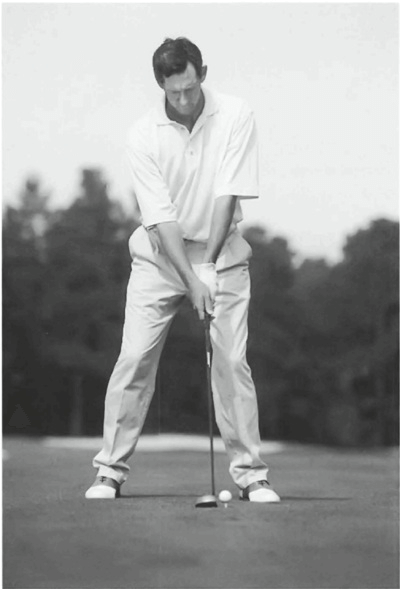
With a 5-iron the shaft is now slightly in front of the clubface. That’s how it was made. So even though your arms are the same in terms of being in front of your body, you have a narrower stance.
You are not trying to make a straight line with your left arm and the club. This is another misconception. That straight line should be there at impact, but not at address.
You’re not getting ready to make impact; you’re getting ready to make a backswing. The backswing is going to set you up for the downswing, which will set you up for impact.
At address your weight is 50–50 between your left and right foot, with a driver maybe 45–55. But when you get to impact most of your weight will be on your left side. This business of trying to create impact at address is just not right.
So the ball position has, in effect, moved back for the 5-iron. If you put the clubhead on the ground behind a ball and let the club sit just the way it was made to, then make your triangle with your hands and arms in front of your body, the ball will find its correct position.
When you get to the sand wedge, the shortest club and the one whose shaft is the most in front of its head, the ball will be as far back as it is going to get. But it will still be ahead of center.
Even for a sand wedge, the ball is still ahead of center within your stance.

The ball doesn’t move more than about two or three inches over the whole set from driver to sand wedge. But it does change.
The change in ball position from sand wedge to driver is no more than a couple of inches.
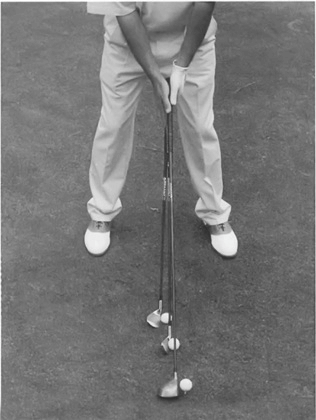
The constant in the setup is the triangle formed by your arms, hands, and shoulders. That is constant. It doesn’t change. The ball position changes because your clubs are made differently.
Pushers and hookers of the ball are generally more comfortable hitting Ball A. Pullers and slicers invariably prefer Ball C. Both, of course, should be trying to hit Ball B.

The Waggle
I always include the waggle when I talk about the setup. A good waggle sets you up to make a good swing. It’s a mini practice swing. So it’s one of the more important parts of the swing. You are practicing your takeaway.
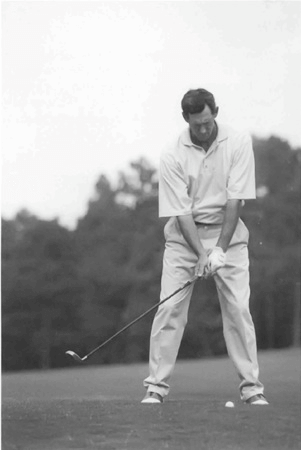
A waggle is also good because it can relax you. It can “pace” your swing and help with your rhythm and tempo. When you waggle the club be specific. Waggle it on plane. Waggle it right along the angle of the shaft, the clubface just opening slightly.
Waggle with your hands. Not with your arms or your shoulders. Soften your hands. Feel a slight upward cocking motion of your wrists along with just a little rotation of the left forearm and hand. Feel a looseness to encourage smoothness in your swing. And practice taking the club back on plane. It’s really important.
PRE-SHOT ROUTINE
For a long time this was one of the most neglected parts of the game. Not anymore. Nowadays I hear many players and teachers talking about the importance of a consistent pre-shot routine. And that’s good. What Idon’t hear, however, are some specifics.
What exactly should you be doing in the last seconds before adopting your address position? And how long should it take?
The best way to answer both those questions is to describe my own pre-shot routine. It isn’t definitive because we are all different. The key is to build yourself a routine that works for you. Then stick with it. Do it every time you hit a shot on the course.
Watch this short 3 minute video to see how it works:

